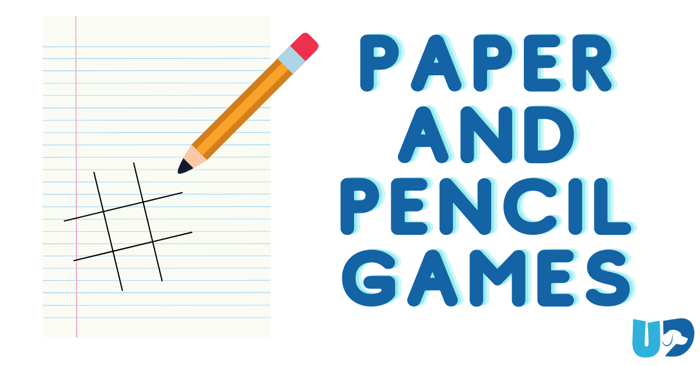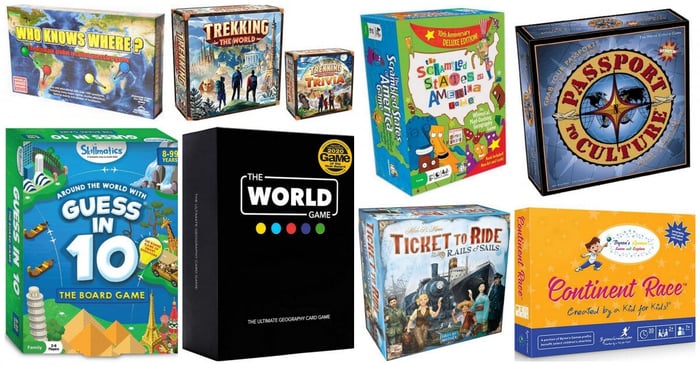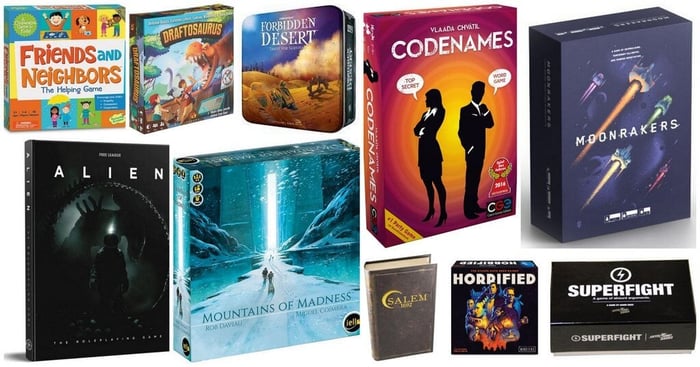We love a good board game (or two, or ten!), but we also love games that don't require anything more than a pencil and some paper. These are the kind of games you can play on the backs of placemats at restaurants, or while you're stuck in a waiting room. Pencil and paper games usually have simple rules, so even smaller kids can get in on the fun. Here are some of our favorites to try with your own family!
Love these games? Get free printables to play them, with rules, examples, and blank playing boards included! Click here for your copy.
Dots and Boxes
Dots and Boxes is one of those pencil and paper games everyone has probably played at least once. Connect the dots to make boxes on a grid, claiming the boxes you make by placing your initial inside. Win the game by claiming the most squares! (2 players)
How to Play
- Start with a grid of dots (at least 10 by 10 is best).
- The first player draws a line, horizontal or vertical, to connect any two adjacent dots.
- The second player does the same. They may continue a line started by the other player, or connect any two other adjacent dots.
- Players continue taking turns. When a player draws a line that completes a box, they write their initial in that box.
- Continue until the board is full and no more boxes can be formed. Count the boxes to determine the winner.
Cram
In Cram, you start with a board that's similar to Dots and Boxes. Each player draws a line on every turn, but this time each dot can only be used once. In the end, the winner is the one who manages to make the final move. (2 players)
How to Play
- Start with a grid of dots (at least 10 by 10 is best). Each player should have a different color of pen or pencil.
- The first player draws a line, horizontal or vertical, to connect any two adjacent dots.
- The second player does the same, but they may not use any dot that has already been linked.
- Game play continues until one player has no dots left to connect. The last player able to make a move is the winner.
Caterpillar
Here's one more game you can play with a grid of dots. In this one, players take turns drawing a single line to connect dots. The line will snake all over the page until finally it can go no further. The last player who's able to play is the winner. (2 players)
How to Play
- Start with a grid of dots (at least 10 by 10 is best).
- The first player draws a line, horizontal or vertical, to connect any two adjacent dots.
- The second player must continue the line from either end, by drawing a horizontal or vertical line to another adjacent dot. Each dot may only be used once as part of the line.
- Play continues until one player makes a move that leaves the other player unable to play, and wins the game.
Battleship
Sure, you can buy Battleship, the board game. But you can also play with just pencil and paper! Draw the grids, place your "ships," and call out coordinates to attack. The one who sinks all their opponents ships first is the victor. (2 players)
How to Play
- Each player draws two grids, each with ten rows and columns. Label the rows 1 to 10, and the columns A to J.
- On one of their grids, each player places their “ships” by outlining squares in a line horizontally or vertically. Players should decide upon the number and size of the ships together; a common option is two ships each of two squares, three squares, four squares, and five squares. Each player should hide their grids from the other.
- Using the second grids, player one “attacks” their opponent by choosing a square and giving its coordinates, ex. “C4.” Player two indicates whether that shot is a hit or a miss.
- If it’s a miss, player one places an X in that square.
- If it’s a hit, both players color in that square on their grids.
- When a hit causes an entire ship to be colored in, the player who owns the ship must announce their ship has been “sunk.”
- Player two then takes a turn, and play continues until one player has sunk all of their opponent’s ships.
Ultimate Tic-Tac-Toe
Tic-Tac-Toe is one of the most classic pencil and paper games, and everyone already knows how to play. Add a twist with this epic version, with boards nested inside boards and a few new rules on where you can make your move. Just like the original, it's simple to learn, but Ultimate Tic-Tac-Toe presents a whole new need for strategy as you play. (2 players)
How to Play
- Draw a large tic-tac-toe grid. In each of the squares, draw a smaller grid. Decide which player will be X and which will be O.
- Player 1 starts by drawing an X in any of the smaller grids.
- Now, it’s Player 2’s turn to make their O. But they can’t play just anywhere on the grid. Instead, they need to look at the move made by player one in the smaller grid, and play in the corresponding square of the larger grid.
- For instance, if Player 1 plays in the upper right corner of a small grid, Player 2 must play in the upper right corner of the large grid. They can play in any open square in that grid.
- Player 1 now does the same, looking at the location of the O in the smaller grid to determine which grid they must play in on the larger board.
- When a player gets three Xs or Os in a row on a small grid, they place their X or O over the entire large square to claim it. If a player’s move sends them to a large square that’s already been claimed and is out of play, they may play anywhere on the board.
- The game ends when one player gets three Xs or Os in a row on the large grid, or until no further moves are possible, in which case the game ends in a tie.
Bulls and Cows
Bulls and Cows has a few other names, and was even turned into the board game Mastermind. It's all about code-breaking, and you can play with letters or numbers. You can choose to limit the number of players the guesser gets, or simply play until they break the code. (2 players)
How to Play
- Draw a simple grid with three columns. Label the columns “Guess,” “Bulls,” and Cows.”
- Player 1 chooses a word or code number and tells the other player how many letters or digits are in it.
- Player 2 guesses a word or number, writing it down in the Guess column. Player 1 then indicates how many “Cows” and “Bulls” they have. “Bulls” are letters or numbers that are in the code, and in the correct place. “Cows” are letters or numbers that are in the code, but in the wrong place.
- Player 1 continues making guesses, with Player 2 telling the numbers of Cows and Bulls, until they correctly guess the word or number.
Word Ladders
This is another familiar game for many. The goal is to try to change one word into another, one letter at a time, while making other words along the way. You can play this one on your own, or compete against others to see who can reach the goal first. (1+ players)
How to Play
- Choose a start word and write it at the top of the page. Choose an end word (of the same amount of letters) and write it at the bottom.
- For each turn, the player changes one letter to make a new word, attempting to form a link between the first and last word. Each turn must form a valid word.
- Multiple players can compete to see who can complete their word ladders in the least amount of moves.
Lexicant
Lexicant seems simple at first, but there's a lot of strategy involved. Players add letters one by one to a stem, trying not to make a complete word. A good vocabulary can help with this game, so it's a fun way for kids to build theirs. (2 players)
How to Play
- Player 1 starts by writing a single letter.
- Player 2 adds a letter before or after. It can be any letter, but the resulting letter combination must be one that appears in a valid word.
- Players should have a “target word” in mind as they play. If the other player challenges their letter choice, they must name their target word to prove that letter combination is valid.
- Player 1 adds a letter to the combination at the beginning or the end. Beginning with this turn (3 letters), players must avoid adding a letter that forms a complete word.
- Play continues, with each player adding letters until one player is forced to add a letter that forms a complete word, thereby losing the game.
Connect 4
Here's another of those pencil and paper games that's also available as a board game. But you can play it anywhere, anytime, by drawing a grid and substituting Xs and Os for checkers. (2 players)
How to Play
- Draw a grid of squares, 7 columns across by 6 rows down.
- Player 1 draws an X in any of the squares on the bottom row.
- Player 2 takes their turn, drawing an O on the board. They can place the O in any open square on the bottom row, or directly above any claimed square.
- Player 1 continues, remembering they can only claim a space in the bottom row or on top of an already claimed square.
- The first player to get four Xs or Os in a row (horizontally, vertically, or diagonally) wins!
Snowman (A Hangman Variation)
Hangman has been around for a long time, but the concept can feel a little violent for playing with little ones. So, try Snowman instead! Draw the body, head, and other parts one by one as players try to guess the mystery word or phrase. (2+ players)
How to Play
- Write the letters of the alphabet across the top of the page.
- Player 1 chooses a mystery word or phrase, and draws blanks to represent each letter of the word or phrase.
- Player 2 guesses a letter.
- If the letter appears in the word or phrase, Player 1 fills in the appropriate blanks. They also cross the letter off the list of available letters to choose from.
- If the letter does not appear in the word or phrase, Player 2 crosses it off the list, then adds one item to the shape of the snowman in this order: bottom circle, middle circle, top circle, top hat, arm one, arm two. (If desired, you can also draw eyes, nose, and mouth to offer more turns.)
- Player 2 continues guessing letters until they solve the puzzle and win, or complete the snowman and lose.
How Many Words?
Everyone's played this one a time or two. Players compete to see who can use the letters of a longer word or phrase to make the most smaller words. It's especially fun to play this one with holiday or season-themed words. (1+ players)
How to Play
- Together, the players decide on a master word or phrase, the more letters the better. Each player writes the word or phrase at the top of their page.
- Set a timer for 2 minutes (or longer, if desired). Each player uses the time to make as many valid smaller words as they can from the master word or phrase.
- Each letter in the master word can only be used once per word, but if there are multiples of a letter in the master word, players can use that letter the same number of times in each word.
- You can make the game harder by requiring all words to be at least 3, 4, or more letters.
- When the time is up, players compare word lists and agree that all words are valid. The player with the most words wins.
- Variation 1: Award points by the number of letters per word, so longer words are more valuable.
- Variation 2: Players read their word lists out, crossing off any words that other players also had. This rewards the player who has the most unique words.
Sprouts
Most pencil and paper games seem to have evolved anonymously over time, but Sprouts was invented by mathematicians at Cambridge in the 1960s. Those who are intrigued by math may want to look into some of the research that's been done into this seemingly simple game!
Players: 2
How to Play:
- Draw two dots on a piece of paper.
- Player 1 draws a from one dot to the other, or from one dot to itself. The line can be straight or curved in any shape. Player 1 then adds a dot somewhere along the new line.
- Player 2 takes their turn, drawing a line from one dot to another, or from one dot to itself. The new line cannot cross the previous line at any point. They then add a dot along the new line.
- Players continue taking turns, following the rules.
- Each new line must connect two dots, or be drawn from one dot around to itself.
- New lines cannot cross previous lines at any point.
- A dot may only be used three times total; one dot may only have three lines running from it.
- The game continues until one player is unable to make a valid move, and the other player wins.
- Variation: The last player able to make a move loses the game (this is known as the misère variation).
Get all these games in one awesome free, printable kit. Download our Pencil and Paper Games Kit here.
Looking for more games you can play on the go? Check out 13 Games to Play in the Car on Your Next Road Trip.





